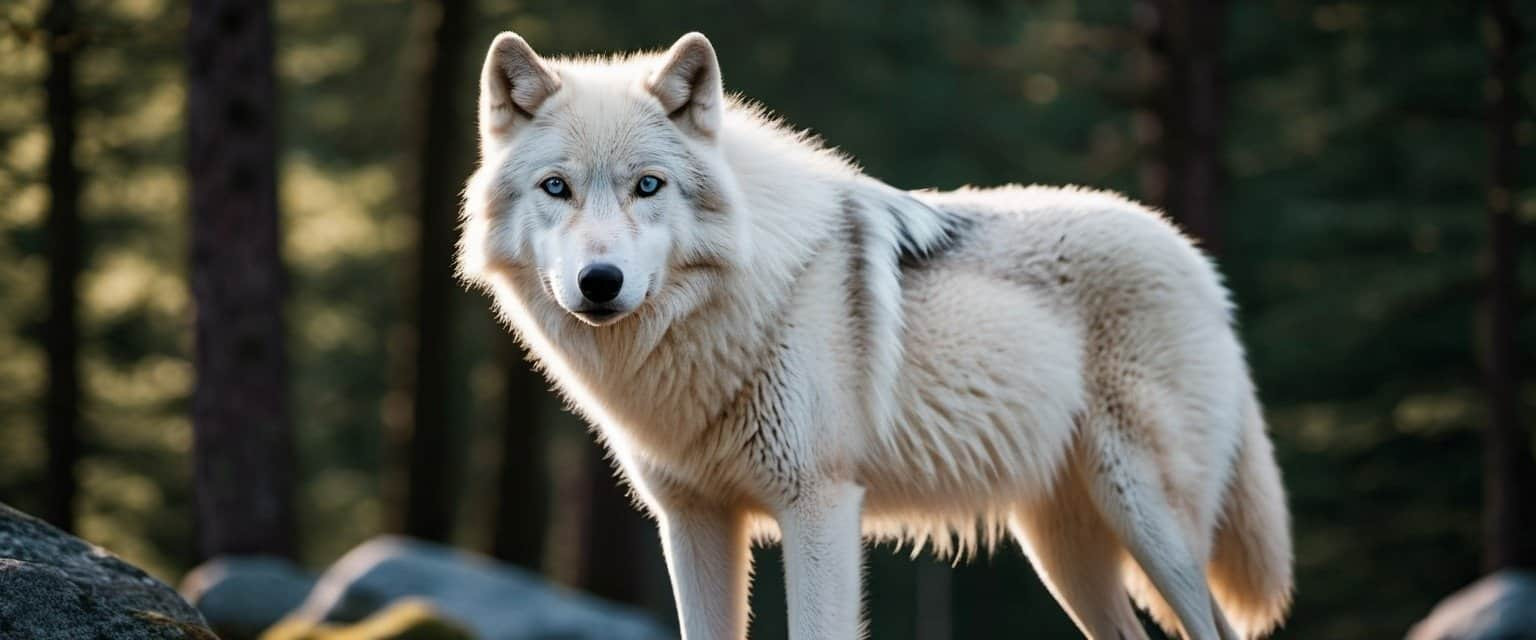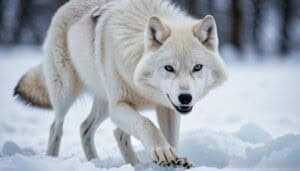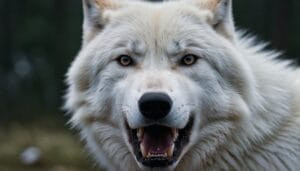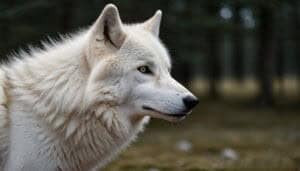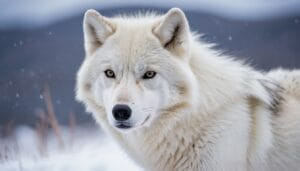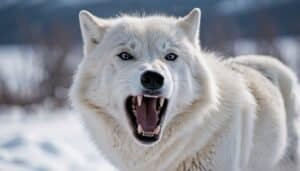Introduction
Understanding the physical characteristics of Arctic wolves is essential to appreciate how these magnificent creatures thrive in some of the harshest environments on Earth. One key feature that plays a significant role in their survival is their tail
In this article, we will explore the length of an Arctic wolf’s tail and delve into various factors that influence it, including genetics, environment, and age. We’ll also compare the tail length of Arctic wolves with other wolf species and examine any variations between males and females
Furthermore, we will discuss the adaptive significance of their tails, focusing on how they aid in survival through balance, thermoregulation, and camouflage. The role of the tail in communication and behavior among Arctic wolves will also be highlighted
Lastly, we will review recorded measurements of Arctic wolf tails and explore the characteristics of their fur density and thermoregulation mechanisms. By the end of this article, you will have a comprehensive understanding of the crucial role the tail plays in the life of an Arctic wolf
What is the Length of an Arctic Wolf’s Tail?
Arctic wolves, with their striking white fur and piercing eyes, are perfectly adapted to the frigid environments they call home. One often overlooked but vital aspect of their anatomy is their tail. But how long is an Arctic wolf’s tail? Let’s dive into the specifics
Average Tail Length
The average length of an Arctic wolf’s tail ranges between 12 to 16 inches (30 to 40 centimeters). This length is crucial for various survival functions that we will explore further
Factors Contributing to Tail Length
Several factors contribute to the variation in tail length among Arctic wolves, including genetics, age, and environmental conditions. Understanding these factors helps us appreciate the diversity and adaptability within the species
Importance of Measuring Tail Length
Measuring the tail length of Arctic wolves not only provides insight into their physical characteristics but also helps researchers understand their health, behavior, and adaptability to changing environments
Factors Influencing Tail Length
Understanding the length of an Arctic wolf’s tail involves looking at several influencing factors. These factors include genetic makeup, environmental conditions, and the developmental stages of the wolf. Let’s explore each of these elements in detail
Genetic Factors
Genetics play a crucial role in determining the physical attributes of any species, and the Arctic wolf is no exception. The length of an Arctic wolf’s tail is primarily influenced by its genetic code, inherited from its parents. These genetic factors ensure that the tail length is suited to the wolf’s overall size and helps maintain its balance and agility in the harsh Arctic environment
Environmental Factors
The environment where an Arctic wolf lives can also affect the length of its tail. Wolves living in colder climates may have slightly longer and bushier tails to help them keep warm. The tail acts as an additional blanket, covering the wolf’s face and nose while it sleeps, helping to conserve body heat in frigid temperatures
Age and Development
As Arctic wolves grow, their tails develop and reach their full length by adulthood. The tail length of a pup is significantly shorter and continues to grow as the wolf matures. Understanding the stages of tail development can give insights into the wolf’s age and its adaptation capabilities at different life stages
Each of these factors—genetic makeup, environmental influences, and developmental stages—combine to determine the length and functionality of an Arctic wolf’s tail, showcasing the intricate balance between biology and environment in these majestic creatures
Comparison and Variations in Tail Length
When it comes to understanding the Arctic wolf, one fascinating aspect to consider is the length of their tails. Not only does tail length vary within the species, but it also differs when compared to other wolf species
In this section, we will explore these comparisons and variations in detail, shedding light on the uniqueness of the Arctic wolf
Arctic Wolf vs. Gray Wolf
The Arctic wolf and the Gray wolf are both majestic creatures, yet they exhibit notable differences in their tail lengths. Generally, the Arctic wolf has a shorter and bushier tail compared to the Gray wolf
This adaptation is crucial for conserving heat in the frigid Arctic environment, whereas the Gray wolf, found in more temperate regions, benefits from a longer tail for balance and agility during long hunts
Arctic Wolf vs. Timber Wolf
Similarly, when comparing the Arctic wolf to the Timber wolf, we see that the Timber wolf’s tail is often longer and less dense. Timber wolves inhabit forested areas where a longer tail helps navigate through thick vegetation and maintain balance over uneven terrain
On the other hand, the Arctic wolf’s shorter, thicker tail helps it endure and survive the harsh, cold climates of the Arctic
Arctic Wolf vs. Red Wolf
The Red wolf, another close relative, also presents a different tail length. Typically, Red wolves have medium-length tails that are less bushy compared to Arctic wolves
The Red wolf’s tail is suited for their habitat in the southeastern United States, where dense, bushy tails are less necessary for thermal insulation
Variations Between Male and Female Arctic Wolves
In addition to species comparisons, there are variations in tail length between male and female Arctic wolves. On average, males tend to have slightly longer tails than females. This difference, although subtle, may be attributed to the larger overall body size of male wolves
Additionally, the tail length in males might play a role in dominance displays and mating rituals, signaling health and vitality to potential mates
Adaptation and Survival Roles of the Tail
The Arctic wolf’s tail is not just a mere appendage; it plays a vital role in the animal’s day-to-day survival. From maintaining balance on icy terrains to regulating body temperature in freezing conditions, the tail is a multifunctional tool that enhances the wolf’s adaptability in the Arctic wilderness. Let’s delve deeper into the specific ways the tail contributes to the Arctic wolf’s survival and adaptation
Balance and Mobility
In the treacherous and icy landscapes of the Arctic, maintaining balance is crucial for the Arctic wolf. The tail acts as a counterbalance when the wolf is running, making sharp turns, or navigating slippery surfaces. This helps prevent falls and injuries, ensuring the wolf can hunt and move efficiently
Thermoregulation
Surviving in sub-zero temperatures requires efficient body heat management. The Arctic wolf’s tail, covered in thick fur, helps to conserve body heat. When the wolf curls up to sleep, it often wraps its tail around its face and paws, minimizing heat loss and keeping vital areas warm
This simple yet effective use of the tail is a testament to the wolf’s remarkable adaptation to its environment
Camouflage
The Arctic wolf’s tail also plays a role in camouflage. The color and texture of the tail blend seamlessly with the snowy and rocky surroundings, making it harder for predators and prey to spot the wolf. This natural camouflage is essential for both hunting and avoiding danger in the wild.
Social Signals
Wolves are highly social animals, and their tails are important communication tools. The position and movement of the tail can convey a range of social signals to other pack members, from dominance and submission to alertness and relaxation
This silent communication is crucial for maintaining pack hierarchy and coordination during hunts
Defensive Mechanisms
When threatened, an Arctic wolf may use its tail as part of its defensive posture. A raised, stiff tail can signal aggression or readiness to defend itself, deterring potential threats. Additionally, the tail can help the wolf maintain balance and agility if it needs to fight or flee from danger
Measurements and Characteristics of Arctic Wolf Tails
Understanding the physical traits of Arctic wolves provides valuable insights into how these majestic animals survive and thrive in their icy habitats. One particularly fascinating aspect is their tail. In this section, we will explore the various measurements and unique characteristics of Arctic wolf tails, providing a comprehensive overview of their average length, extreme variations, and the distinct features that set them apart
Recorded Measurements
The length of an Arctic wolf’s tail is a noteworthy feature, varying slightly among individuals but generally maintaining a consistent range. On average, an Arctic wolf’s tail measures between 12 to 16 inches (30 to 40 centimeters). These measurements can be influenced by several factors, including genetics and environmental conditions
However, extremes in tail length have been recorded, with some Arctic wolves boasting tails as long as 20 inches (50 centimeters) or as short as 10 inches (25 centimeters), highlighting the natural diversity within the species
Fur Density and Thermoregulation
The density of fur on an Arctic wolf’s tail is another critical characteristic that plays a vital role in their survival. The tail is densely covered with thick fur, which provides insulation against the frigid Arctic temperatures
This dense fur helps to conserve body heat and is particularly important during the coldest months. Additionally, the fur density on the tail can change seasonally, becoming thicker in winter to offer extra protection and slightly thinner in summer when the temperatures are relatively warmer
This adaptability showcases the Arctic wolf’s remarkable ability to regulate its body temperature and maintain comfort throughout the year.
Mechanisms of Heat Retention
The tail of an Arctic wolf is not just about looks; it serves a functional purpose in heat retention. During extreme cold, Arctic wolves often wrap their tails around their bodies, covering their nose and face to keep warm. This behavior demonstrates the tail’s crucial role in thermoregulation
The thick fur acts as a barrier against the cold, trapping heat close to the body and preventing heat loss. This mechanism is vital for the wolf’s survival in the harsh Arctic environment, where temperatures can plummet to well below freezing
Conclusion
The Arctic wolf’s tail is a fascinating feature that plays a vital role in its survival and adaptation to the harsh Arctic environment. We began by examining the factors that influence tail length, including genetics, environmental conditions, and age, providing a foundation for understanding the variations observed among these wolves
Our comparison of Arctic wolf tails with other wolf species, as well as between males and females, highlighted both the uniqueness and the commonalities within the Canidae family
We delved into the adaptive functions of the tail, emphasizing its importance for balance, thermoregulation, and camouflage, which are crucial for navigating and thriving in the icy terrain. Additionally, we explored the tail’s role in communication and behavior, illustrating how it serves as a tool for social interaction and defense
In our detailed examination of measurements and characteristics, we discovered the average tail length of Arctic wolves and noted the extremes, showcasing the diversity within the species. The discussion on fur density and its seasonal variations revealed how the tail helps in conserving body heat, while the mechanisms of heat retention underscored its critical function in protecting the wolf from extreme cold
In summary, the Arctic wolf’s tail is much more than a simple appendage; it is a multifunctional adaptation that enables these magnificent animals to endure and flourish in one of the most challenging environments on Earth
Understanding these characteristics not only enriches our knowledge of Arctic wolves but also deepens our appreciation for the intricate ways in which nature equips its creatures for survival
